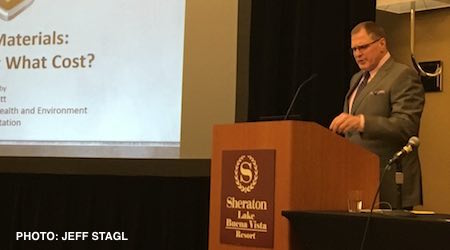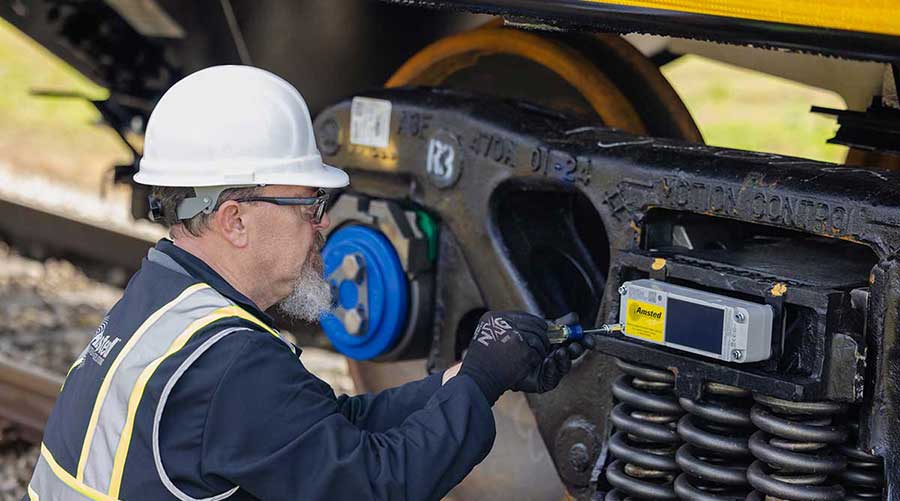Stay updated on news, articles and information for the rail industry
March 2016
Rail News: Rail Industry Trends
Secure Rail 2016: A recap

CSX's Skip Elliott described a soon–to–be–launched Web app that will list the hazardous materials the Class I moves in a certain state.
By Jeff Stagl, Managing Editor
Issues and trends surrounding both physical and cyber security in the North American rail industry were heavily discussed at Progressive Railroading’s second annual Secure Rail conference.
Held Feb. 9 and 10 in Orlando, Fla., the event attracted more than 100 representatives from a cross-section of the industry, including Class Is, short lines, transit and government agencies, suppliers and service providers.
The conference featured 20 presentations on freight- and transit-rail topics, ranging from emerging security technologies and trends to Internet security to the role of railroad police departments. Secure Rail also featured several networking opportunities and a product showcase that highlighted the rail security products, services and technologies offered by eight event sponsors.
Sessions on the Transportation Security Administration’s (TSA) national strategy, the current and future applications of unmanned aerial vehicles, and policing and securing railroads in Los Angeles drew some of the largest crowds.
During his lead-off presentation Feb. 9 on the TSA’s national strategy for surface transportation security, Manager of Freight Rail Security Scott Gorton described how the administration is striving to safeguard the free movement of people and goods. Improvised explosive device attacks are the most likely threat to surface modes, while public transportation systems are more susceptible to attacks involving standoff weapons, small arms or biological agents, said Gorton.
How much is too much?
Later that morning, CSX Vice President of Public Safety, Health and Environment Skip Elliott said the Class I planned to launch a Web application early in the second quarter that would enable the public to learn which hazardous materials the railroad was moving through a particular state. However, there is an increased risk to homeland security if a railroad provides the general public too many details about haz-mat movements, he said.
The event’s second day on Feb. 10 included equally eventful presentations. A morning session helmed by Los Angeles County Metropolitan Transportation Authority Executive Officer for Security and Law Enforcement Alex Wiggins and Los Angeles County Sheriff’s Department Transit Policing Bureau Chief Ronene Anda provided info on a Transit Watch application available to riders using an iPhone or Android smartphone. The app features the U.S. Department of Homeland Security’s (DHS) eight signs of terrorism related to transit.
Human trafficking vs. smuggling
In the afternoon, the event closed with a presentation on the DHS’ human trafficking awareness program — the Blue Campaign — that the agency has partnered with Amtrak, among others, to disseminate. Scott Santoro, the senior training adviser for DHS’ Federal Law Enforcement Training Center, described how human trafficking differs from human smuggling. Sex or labor trafficking involves a crime against a person via involuntary exploitation, he said.
Meanwhile, through its own awareness program, Amtrak has trained all police officers, train and onboard service workers, station managers and about 8,000 frontline employees on human trafficking, said Amtrak Police Department Lead Communications Specialist James Lewis.
 Rail-Car Outlook '25: Definitely not 'Back to the Future' anytime soon — forecast by Richard Kloster
Rail-Car Outlook '25: Definitely not 'Back to the Future' anytime soon — forecast by Richard KlosterKeywords
Browse articles on Secure Rail conference rail security Skip Elliott Transportation Security Administration U.S. Department of Homeland Security Scott Gorton Amtrak human trafficking Alex Wiggins Ronene Anda Los Angeles County Metropolitan Transportation Authority the Blue Campaign James LewisContact Progressive Railroading editorial staff.


 LRW Honors Amtrak’s Acheson As Railway Woman Of The Year
LRW Honors Amtrak’s Acheson As Railway Woman Of The Year
 From Editor-In-Chief Foran: Of Gender Equity And Inclusion
From Editor-In-Chief Foran: Of Gender Equity And Inclusion
 Spotlight On Some Of Today’s Rail Safety Products
Spotlight On Some Of Today’s Rail Safety Products
 Women of Influence in Rail eBook
Women of Influence in Rail eBook
 railPrime
railPrime





